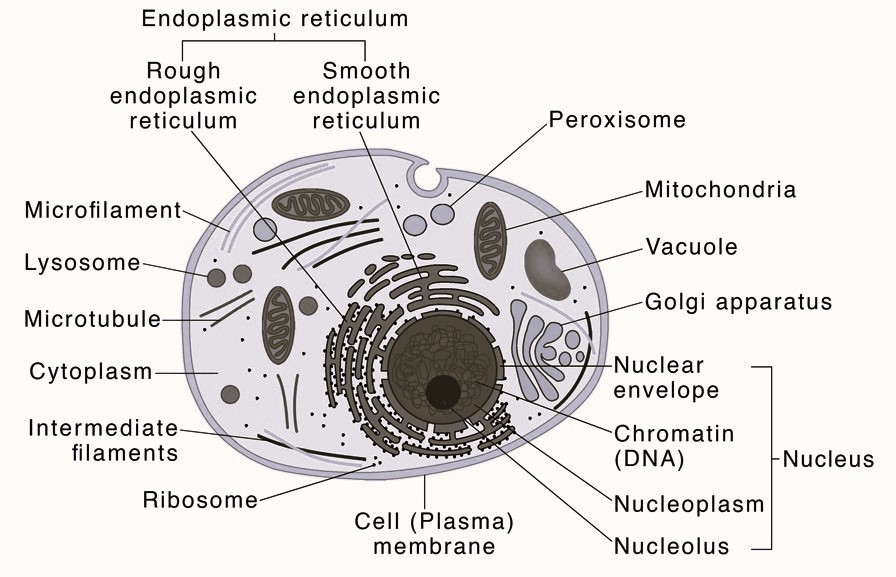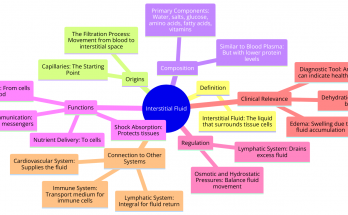Eukaryotic Cell
Eukaryotic Cell is a type of cell that contains a defined nucleus and other membrane-bound organelles such as mitochondria , endoplasmic reticulum etc . Eukaryotic cells are found in all complex organisms like plants, animals, fungi etc. Eukaryotic cells are typically larger than prokaryotic cells. Prokaryotic cells lack a nucleus and other membrane-bound organelles. Eukaryotic Cells are the basic unit of life for most multicellular organisms.
Also Check – 16 Important Differences between Prokaryotic and Eukaryotic cell
Diagram of The Eukaryotic Cell

Description of Eukaryotic Cell Diagram labels is as follows-
This is an extensive network of membrane-bound flattened sacs and tubules or channels that run through the cytoplasm. The Endoplasmic reticulum helps in protein synthesis, folding, and modification of proteins before they are transported to other parts of the cell or outside. There are 2 types of Endoplasmic Reticulum – Rough Endoplasmic Reticulum and Smooth Endoplasmic Reticulum.
Also check – 6 Important Difference between Rough and Smooth Endoplasmic Reticulum
Peroxisome
Peroxisomes are spherical small, membrane-bound organelle that play an important role in cellular detoxification, degradation of fatty acids,breakdown of fatty acids and the detoxification of harmful substances.
Also Check- Cell Organelles – The Complete Guide
Mitochondria are called the “Powerhouses” of the cell as they are responsible for producing ATP (adenosine triphosphate), the cell’s main energy source through cellular respiration.
Vacuoles are large fluid-filled sacs that store water, waste, and other substances.Plant cells, vacuoles are bigger as compared to animal vacuoles. They are responsible for maintaining turgor pressure, which helps the cell maintain its shape.
Golgi Apparatus is a series of flattened membranous stacks that sort and modify proteins and lipids, and package them into vesicles for transport to other parts of the cell or outside.
Nuclear Envelope
Nuclear Envelope is a double membrane that surrounds the nucleus and separates it from the cytoplasm. It helps to maintain the integrity of the genetic material inside the nucleus.
Chromatin
Chromatin is a complex mixture of DNA and protein that makes up the chromosomes. It carries the cell’s genetic information and is located in the nucleus.
Nucleoplasm
Nucleoplasm is the gel-like substance inside the nucleus that surrounds the chromatin and the nucleolus.
Nucleolus
Nucleolus is a specialized structure inside the nucleus that plays an important role in the synthesis of ribosomal RNA (rRNA) and the formation of Ribosomes .
Nucleus is a membrane-bound structure that contains the cell’s genetic material (DNA) and acts as the brain or control center of the cell by directing its activities.
Cell Membrane is a thin, flexible lipid bilayer that surrounds the cell. Cell Membrane is selectively permeable allowing certain substances to enter and exit the cell.
Also Check – 11 Difference between Cell Wall and Cell Membrane (Plasma Membrane)
Ribosome
Ribosomes are tiny cellular structures composed of protein and RNA .It functions as a molecular machine to synthesize proteins.they are Found in are found in the cytoplasm and the Endoplasmic Reticulum.
Intermediate Filaments
Intermediate Filaments are cytoskeletal protein fibers that provide structural support to cells and help maintain cell shape. It also resists mechanical stress on the cell.
Cytoplasm is the gel-like substance that fills the interior of the cell excluding the nucleus. Cytoplasm contains all the cell organelles and other components.
Microtubules
Microtubules are long thin cytoskeletal protein fibers that help maintain the cell’s shape. It supports the cell during division . Microtubules are involved in the movement of organelles and other substances within the cell.
Lysosomes are membrane-bound small, spherical organelle structures that contain digestive enzymes used to break down cellular waste and old organelles.
Microfilaments
Microfilaments are thin cytoskeletal protein fibers that help maintain the cell’s shape. It resists mechanical stress and is involved in cell movement and division.
Did you find this article helpful? We’d love to hear your thoughts and suggestions in the comments!
Also Check – 10 Important Difference between Cell organelles and Cell Inclusions

One Comment on “Diagram of Eukaryotic Cell”